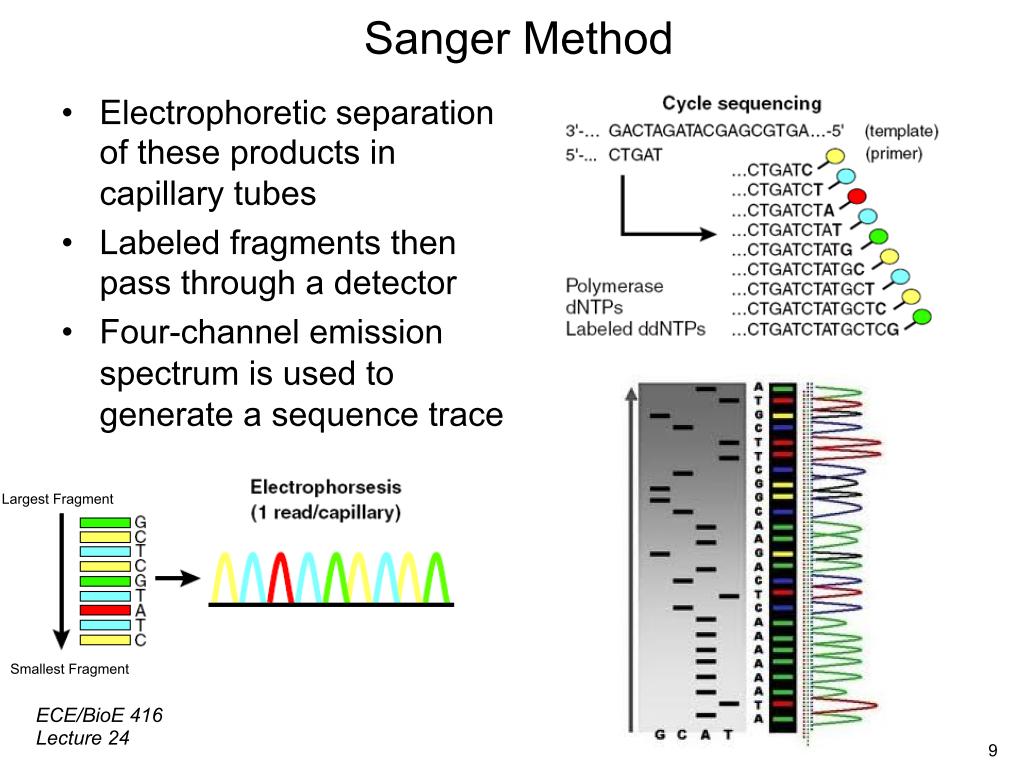

Despite what was achieved, its considerable accuracy, and widespread availability have been overshadowed by several outstanding limitations that have bottle-necked its use in modern applications. Sanger Sequencing has, for the first time ever, allowed scientists to sequence DNA originating from many organisms which has improved our understanding of pathogens, the origins of disease, and the world around us. Sanger Sequencing provided a Launchpad for New and Innovative Technologies Capillary gel electrophoresis to separate the terminated fragments by size and laser excitation for detection. The elongation process occurs in a single reaction mixture where the addition of fluorescently labeled ddNTP results in termination. The target DNA is fragmented, amplified, denatured, and bound to a primer. 3 As a result, this allows scientists to obtain the entire DNA sequence once all the terminated DNA fragments have passed through the laser.įigure 2: Automated Sanger Sequencing Technology. 3 Towards the end of the capillary tube, there is a laser that excites the fluorophore incorporated onto the elongating strand of the DNA molecule to generate a peak that is recorded onto a graph (Figure 2C). In this improved variation of Sanger’s Sequencing, the gel electrophoresis occurs in a capillary tube, another important aspect of automation (Figure 2B). 3 Sanger Sequencing & Data Analysis 2.0įollowing the same principle and upon completion of the chain-terminating reaction, all the components of this test tube are subjected to gel electrophoresis, which separates the various terminated DNA molecules according to size (Figure 2A). Over the following years, Sanger Sequencing experienced several improvements that have allowed for automation of the technology, through the use of fluorescent labels called fluorophores that are bound to the chain-terminating dideoxynucleotides and computers for data acquisition and analysis. Gel electrophoresis to separate the terminated fragments by size. The four reaction mixtures which contain the different radiolabeled ddNTPs where the elongation and termination take place. 1,2įigure 1: Sanger Sequencing Technology. Given the very limited technology available at the time, the accuracy, robustness, and ease of use made Sanger’s Sequencing one of the most common DNA sequencing technologies used for many years to come. 2 Next, by moving up the gel and recording the ddNTP in the sequence, scientists can obtain the sequence of the target DNA molecule (Figure 1C). The entire gel is then placed under an X-ray or UV light that enables visualization of the radiolabelled ddNTPs. Once the reaction is complete, the DNA fragments are subjected to gel electrophoresis which separates the terminated DNA fragments according to size, where the shortest strands move through the gel the fastest (Figure 1C). 2 It is important to note that these ddNTPs are labeled with radioactive molecules which is important for identification as each type of ddNTP has a unique radioactive emission. 2 And since there are many different DNA strands being elongated and terminated in the same test tube, you end up with DNA fragments of varying lengths and molecular weights due to the incorporation of the ddNTP at each nucleotide position on the DNA fragment. Whenever the ddNTPs are incorporated into the elongating strand, DNAP can no longer elongate the DNA strand, terminating the process. This reaction occurs in four different reaction tubes where each also contains one of the four chain-terminating variations of the dNTPs called dideoxynucleotides (ddNTP) (Figure 1B). Next, DNA polymerase (DNAP) adds deoxynucleotide triphosphates (dNTPs) in solution adjacent to the primer based on complementarity, and this process continues until it reaches the end of the ssDNA. To prepare the target DNA for sequencing, it is first broken up into short fragments that are denatured into two single-stranded DNA (ssDNA) fragments and a shorter DNA sequence called a primer binds to the ssDNA through complementary base pairing (Figure 1A). 1 This DNA sequencing technology, called Sanger Sequencing or the Chain Termination Method, works in the following manner. Frederick Sanger in the 1970s who is often referred to as the ‘father of genomics’ and received a Nobel prize in 1980 for his ground-breaking invention. The very first DNA sequencing technology was created by Dr.


 0 kommentar(er)
0 kommentar(er)
